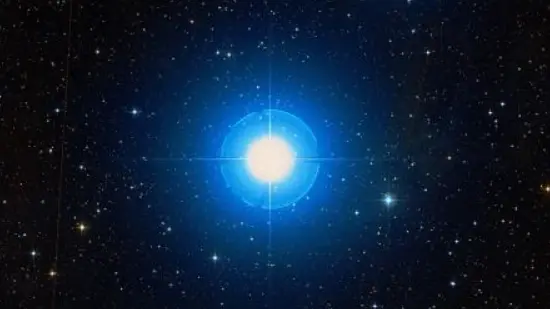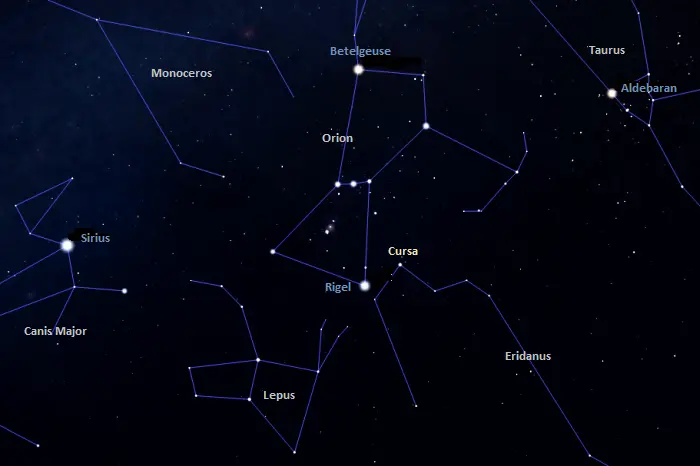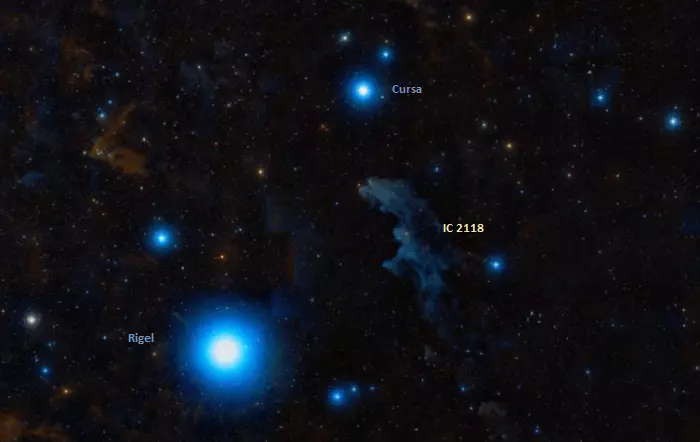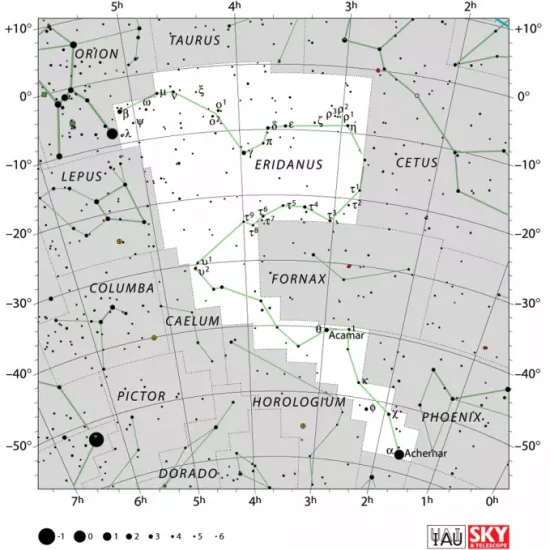Cursa, Beta Eridani (β Eri), is an A-type giant star located in the constellation Eridanus. With an apparent magnitude of 2.796, it is the second brightest star in Eridanus, after Achernar. It lies 90 light-years away and appears near Rigel in the sky.
Star type
Cursa is a white giant of the spectral type A3III. It is sometimes classified as a subgiant (A3IV). The star has evolved away from the main sequence after consuming the hydrogen in its core and is on its way to cooling and expanding into an orange giant.
Cursa has a radius 2.4 times that of the Sun and a mass twice that of our star. With an effective temperature of 8,104 K, it is 25 times more luminous than the Sun.
The star is a very fast spinner, with a projected rotational velocity of 196 km/s. A 2002 study that analyzed rotational velocities of A-type stars listed it as a probable double star.

Cursa (Beta Eridani), image: Wikisky
Facts
Beta Eridani is a suspected variable star. Its brightness has been observed to vary from magnitude 2.72 to 2.80.
Cursa is one of the few known stars that exhibit enormous flashes. It experienced a huge flare-up in 1985. The flare increased the star’s brightness by three magnitudes for more than two hours. There are about a dozen other stars known to exhibit such flashes. They include the supergiant Enif, the brightest star in Pegasus, and the variable red supergiant Mu Cephei (Garnet Star) in Cepheus.
Cursa may be a member of the Ursa Major Moving Group (Collinder 285), the nearest moving stellar group to the Sun. The Ursa Major association includes five of the seven Big Dipper stars and the stream members Menkalinan in the constellation Auriga, Alphecca in Corona Borealis, Skat in Aquarius, Adhafera in Leo, and Gamma Leporis in Lepus. A 2002 study found that the kinetic properties of Cursa indicate that it is a member, but its photometric properties suggest that it may not be.
Cursa has a visual companion separated by 120 arcseconds. The companion is catalogued as CCDM J05079-0506B and has an apparent magnitude of 10.90.
Name
The name Cursa (pronunciation: /ˈkɜːrsə/) comes from the Arabic phrase Al Kursiyy al Jauzah, meaning “the chair/footstool of the Central One.” It was sometimes spelled Kursa. The traditional Arabic name was also used for Psi Eridani (Al Kursiyy al Jauzah I) and Lambda Eridani (Al Kursiyy al Jauzah II). These stars and Tau Orionis formed the celestial chair. The stars appear close to Rigel, the bright star that marks the foot of Orion.
In Arabic astronomy, al Jauzah (the Central One) was a feminine figure in old Arabian legend, but the origin of the name is uncertain. The name of Alpha Orionis (Betelgeuse) is derived from it.
The name Cursa was approved by the International Astronomical Union’s (IAU) Working Group on Star Names (WGSN) on July 20, 2016.
Beta Eridani was also traditionally known as Dhalim. The name was derived from Al Thalim (al-ẓalīm), meaning “the ostrich.” In earlier Arabic astronomy, the star was part of an asterism known as the Ostrich’s Nest. The name was also used for Acamar (Theta Eridani). The name Dalim now formally applies only to Alpha Fornacis, the brightest star in the constellation Fornax (the Furnace).
In Chinese astronomy, Cursa was called 玉井三 (Yù Jǐng sān), the Third Star of Jade Well. The Jade Well was an asterism formed by Cursa with the hot blue stars Lambda Eridani, Psi Eridani, and Tau Orionis. The asterism was part of the Three Stars mansion (referring to Orion’s Belt), one of the western mansions of the White Tiger. The Three Stars mansion represented the body of the White Tiger.
Location
Cursa is very easy to find. It is located at the northeastern end of the River (Eridanus), near the familiar hourglass figure of Orion. It lies just northeast of Orion and is the brightest star in the region between Rigel and Orion’s shield.

The location of Cursa, image: Stellarium
Cursa and Rigel can be used to find the Witch Head Nebula (IC 2118), a faint reflection nebula illuminated by Rigel, located approximately 900 light-years away. The nebula is known for its peculiar shape, which resembles the profile of a witch’s face. It is believed to be the remnant of an ancient supernova.

Rigel, Cursa and the Witch Head Nebula, image: Wikisky
Constellation
Cursa is located in the constellation Eridanus. Representing the celestial River, Eridanus is one of the Greek constellations, first catalogued by Claudius Ptolemy in the 2nd century CE. It is traditionally depicted as a river flowing from Orion all the way to the far southern sky, where the bright Achernar (Alpha Eridani) marks its end.
Eridanus is the sixth largest constellation in the sky, stretching across 1138 square degrees of the mostly southern sky. It extends farther from north to south than any other constellation. Its northernmost part lies on the celestial equator.

Eridanus constellation map by IAU and Sky&Telescope magazine
Eridanus is known for being home to the hot blue star Achernar, the ninth brightest star in the sky, and the orange dwarf Ran (Epsilon Eridani), the 12th individual nearest star to the Sun and the third nearest star visible to the unaided eye (after Alpha Centauri AB and Sirius).
Other notable stars in Eridanus include the binary star Theta Eridani (Acamar), the triple star system 40 Eridani, the variable red giant Zaurak (Gamma Eridani), and the Sun-like star 82 G. Eridani, which is home to at least three exoplanets.
Deep sky objects in the constellation include the planetary nebula NGC 1535, the reflection nebula IC 2118 (the Witch Head Nebula), the grand design barred spiral galaxy NGC 1300, and the ring galaxy NGC 1291. Eridanus also hosts the Eridanus Supervoid (WMAP Cold Spot), a vast area, about a billion light-years across, that is devoid of galaxies.
The best time of the year to see the stars and deep sky objects in Eridanus is during the month of December, when the constellation appears higher in the evening sky. The entire constellation is visible from locations south of the latitude 32° N.
The 10 brightest stars in Eridanus are Achernar (Alpha Eri, mag. 0.40 – 0.46), Cursa (Beta Eri, mag. 2.796), Acamar (Theta1 Eri, mag. 2.88), Zaurak (Gamma Eri, mag. 2.88 – 2.96), Rana (Delta Eri, mag. 3.51 – 3.56), Upsilon4 Eridani (mag. 3.55), Phi Eridani (mag. 3.55), Chi Eridani (3.70), Tau4 Eridani (mag. 3.57 – 3.72), and Ran (Epsilon Eri, mag. 3.736).
Cursa – Beta Eridani
| Spectral class | A3III var or A3IV |
| Variable type | Suspected |
| U-B colour index | +0.124 |
| B-V colour index | +0.110 |
| R-I colour index | +0.08 |
| Apparent magnitude | 2.796 |
| Absolute magnitude | +0.59 |
| Distance | 90.0 ± 0.9 light-years (27.6 ± 0.3 parsecs) |
| Parallax | 36.2456 ± 0.3575 mas |
| Radial velocity | -6 ± 0.8 km/s |
| Proper motion | RA: –88.481 ± 0.257 mas/yr |
| Dec.: -70.497 ± 0.265 mas/yr | |
| Mass | 2.0 M☉ |
| Luminosity | 25 L☉ |
| Radius | 2.4 R☉ |
| Temperature | 8,360 or 8,104 K |
| Metallicity | -0.4 dex |
| Rotational velocity | 196 km/s |
| Surface gravity | 3.58 cgs |
| Constellation | Eridanus |
| Right ascension | 05h 07m 50.9748855092s |
| Declination | −05° 05′ 11.389144311″ |
| Names and designations | Cursa, Beta Eridani, β Eri, 67 Eridani, 290 G. Eridani, HD 33111, HR 1666, HIP 23875, SAO 131794, FK5 188, BD−05 1162, GC 6274, GCRV 3046, GJ 9175, JP11 990, PPM 187729, PLX 1158.00, IRAS 05053-0509, 2MASS J05075100-0505109, TYC 4759-1671-1, Gaia DR3 3211922645854328832, UBV 4929, CCDM J05079-0506A, IDS 05030-0513 A, WDS 05078-0505A |